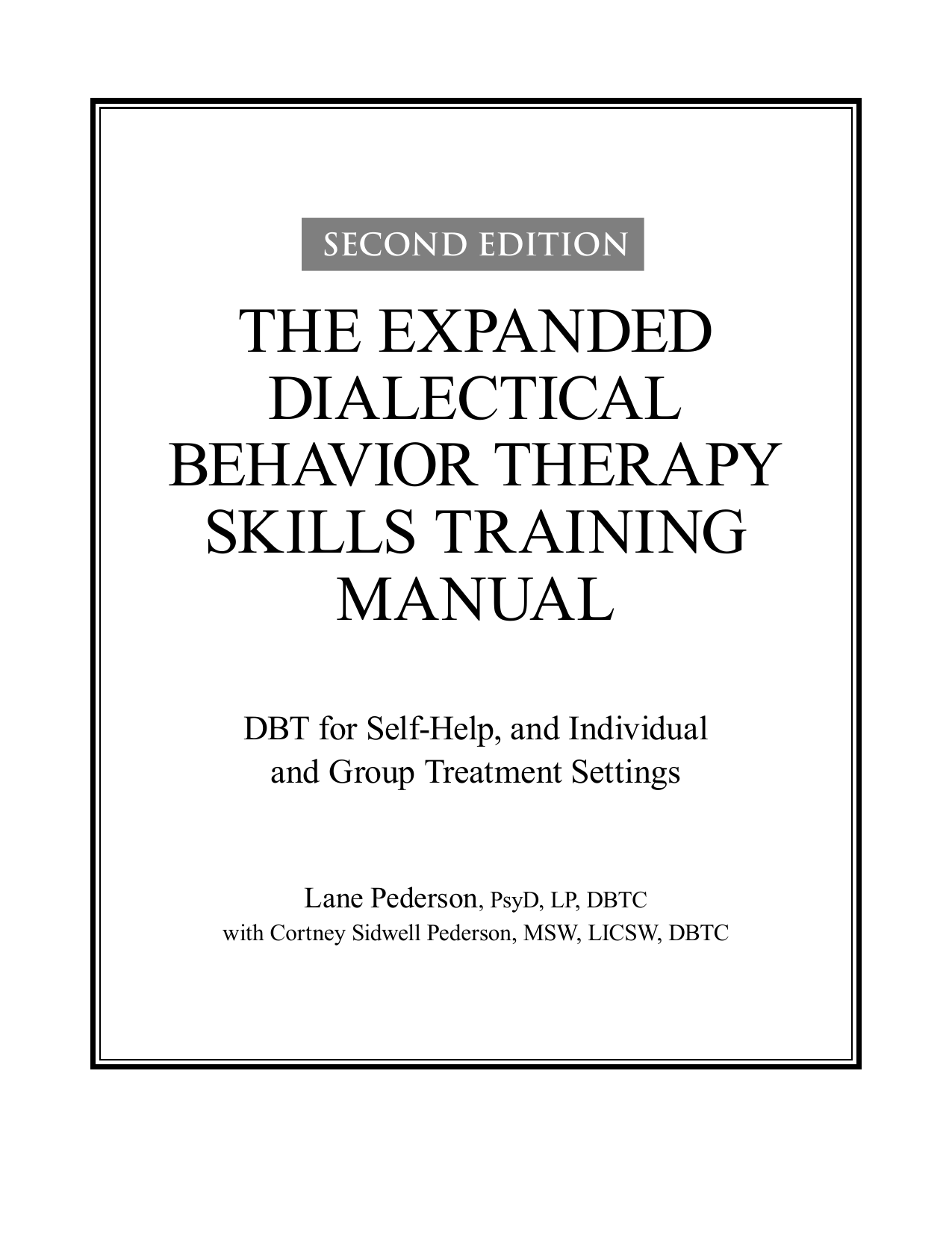- Randy Wolbert, LMSW, CAADC, CCS joins the Therapy For Real Life Podcast to discuss where behavior therapy and mindful spiritual practices align. Randy shares his own path to Zen, which overlaps with a long career in providing Dialectical Behavior Therapy, clinical supervision, and DBT trainings around the world. Host Anna Lindberg Cedar, MPA, LCSW asks Randy to explain how DBT's core theories.
- Behavioral Tech specializes in training mental health professionals in clinical applications of DBT. Persons planning to conduct DBT skills training with non-clinical populations are advised to consult current research from experts pioneering these applications and to read the DBT Skills Training Manual.

Applied Behavioral Analysis Cope With Anxiety Social Cognitive Approach Progressive Muscle Relaxation Dialectical Behavior Therapy. TERMS IN THIS SET (30) Basic Assumptions of Behavior Therapy - The individual is the producer and product of their environment. Adheres to the scientific method and empirical evidence to derive effective.
How many times have we been told to relax? The typical result of such a question is becoming more uptight or even angry.
The health benefits of relaxation are summarized by the Mayo Clinic:
Training Courses Dialectical Behavior Therapy


Applied Behavioral Analysis Cope With Anxiety Social Cognitive Approach Progressive Muscle Relaxation Dialectical Behavior Therapy. TERMS IN THIS SET (30) Basic Assumptions of Behavior Therapy - The individual is the producer and product of their environment. Adheres to the scientific method and empirical evidence to derive effective.
How many times have we been told to relax? The typical result of such a question is becoming more uptight or even angry.
The health benefits of relaxation are summarized by the Mayo Clinic:
Training Courses Dialectical Behavior Therapy
- Slows heart rate.
- Lowers blood pressure.
- Slows your breathing rate.
- Improves digestion.
- Maintains normal blood sugar levels.
- Reduces activity of stress hormones.
- Increases blood flow to major muscles.
- Reduces muscle tension and chronic pain.
Most of us know that relaxation is good for us, but few people actually know how to relax. The good news is that relaxation can be learned. And learning how to relax is what we believe to be a key component of peak performance at work and in life as a whole.
Renowned Ecologist and meditation teacher John P Milton, in his book Sky Above, Earth Below, lists four conditions that are required in the relaxation process:
'…first, good instruction in helping you discover where your blockages are; second, learning the techniques of relaxation from a good teacher; third, locating a supportive environment, ideally one in Nature, where you can formally practice relaxation regularly; and fourth, cultivating relaxation at least once or twice a day.'
Building on what John wrote, the entire body is meant to flow naturally like a beautiful stream or river.
- Our circulatory system moves blood around body via the heart, arteries and veins, delivering oxygen and nutrients to organs and cells and carrying their waste products away.
- Our Digestive system circulates nutrients via the mouth, esophagus, stomach and intestines and eliminates waste from the body.
- Our endocrine system moves chemical communications within the body using hormones.
- Our integumentary system/ Exocrine system flows to produce skin, hair, nails, sweat and other exocrine glands
- Our lymphatic system comprises a network of lymphatic vessels that carry a clear fluid called lymph.
- Our immune system defends the body against pathogenic viruses that may endanger the body.
- Our muscular system enables the body to flow and move using muscles.
- Our nervous system collects and processes information from the senses via nerves and the brain, and tells the muscles to contract to cause physical actions.
- Our renal system / urinary system/ excretory system is where the kidneys filter blood.
- Reproductive system: the sex organs required for the production of offspring.
- Our respiratory system involves the lungs and the trachea that bring air into and out of the body.
- Skeletal system. The bones supporting the body and its organs. (from Wikipedia)
Dialectical Behavioral Therapy Definition
When we are uptight, constrictions and blockages occur that can negatively effect any or all of these vital systems. Links the kodá ly aspiring music classroom lesson. We need the proper instruction on HOW to relax, and fortunately these techniques are easily taught. We also want to find a special place in wild nature, a park, our backyard, or even a lone tree, some connection to nature to help support the process. And finally, like anything, we need to practice daily if we want to get good at it.
In the simple and quick practice below, you will begin to learn how to:
- Identify where you are holding tension
- Set the intention to relax
- A specific technique to calm your body and mind
- The ability to let go little by little
- How to trust and go deeper
- And, ultimately, how to progressively surrender into everything that is happening right now
Relaxationdialectical Behavioral Training Programs
Progressive Muscle Relaxation Practice
Progressive muscle relaxation is a practice that relaxes your mind and body by tensing and relaxing muscle groups throughout your body. You will tense each muscle group, without excessive straining, and then suddenly release the tension and observe how it feels to be relaxed. Throughout this exercise, you may visualize the muscles tensing and a wave of relaxation flowing over them as you release that tension. It is also important that you keep breathing throughout this practice. Let's get started!
- Establish a comfortable posture. You can do this practice seated or standing, but for our initial purposes let's start in a seated posture.
- Be aware that you are sitting in a chair. Be aware of the parts of your body that are being supported. You might notice sensations in your hands. You can also be aware that your feet are touching the ground.
- Lift up your heels and tighten the muscles in your calves. Notice what that tension feels like. Hold for a few seconds and release. Notice the difference.
- Now, straighten your legs out in front of you lifting your feet off of the ground. Tighten the muscles in your thighs. Notice what that tension feels like. Hold for a few seconds and let it go on an exhale. Notice the difference.
- To the best of your ability, tighten the muscles in your abdomen. Notice what that tension feels like. Hold for a few seconds and let it go on a sigh. Notice the difference.
- Press your palms together in front of you so you're tightening the muscles in your chest. Notice what that tension feels like. Hold for a few seconds and let it go on a sigh. Notice the difference.
- Take a few deep cycles of breath here, inhaling low into the abdomen and exhaling slowly.
- Lift your shoulders up like you're trying to touch your ears. Notice the tension and with a sigh, let it go.
- Flex your arm to the degree you can. Notice the tension and with a sigh, let it go.
- Clench your fists and hold. Notice the tension in your hands and forearms, and with a sigh, let it go.
- Scrunch up all the muscles of your face. Notice the tension and with a sigh, let it go.
This simple sequence of tensing and relaxing is the basis of a progressive muscle relaxation practice. This technique is a wonderful way to slow down excessive thinking and rumination, and creates awareness of your body in a new way, encouraging you to notice what it feels like to be tense vs. relaxed in the present moment. We encourage you to play with this practice and make it your own and we hope it helps you find a little more ease in your everyday. Have fun with it!
Dell download manager windows 7. Whether you're working on an Alienware, Inspiron, Latitude, or other Dell product, driver updates keep your device running at top performance. Step 1: Identify your product above. Step 2: Run the detect drivers scan to see available updates. This package provides the Dell Mobile Broadband Manager Application and is supported on Inspiron, XPS Notebook, Vostro Notebook and Latitude models that are running the following Windows Operating Systems: XP, Vista and Windows 7. Get the latest driver Please enter your product details to view the latest driver information for your system. Dell System Manager Application This package provides Dell System Manager Application and is supported on OptiPlex, XPS Notebook, Tablet, Precision and Latitude models that are running the following Windows Operating Systems: Vista and Windows 7. Get the latest driver.

